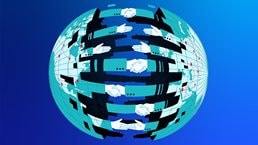At a glance
- No region is close to being self-sufficient. Every region relies on trade with others for more than 25 percent of at least one important type of good.
- About 40 percent of global trade is “concentrated.” Importing economies rely on three or fewer nations for this share of global trade.
- Three-quarters of this concentration comes from economy-specific choices. In these cases (30 percent of global trade), individual countries source a product from only a few nations, even when global supply options are diversified.
- Over the past five years, the largest economies have not systematically diversified the origins of imports. All have vulnerabilities, some more than others.
- Informed reimagination of global trade requires a granular approach¸ both in mapping concentrated trade relationships and in deciding on action—whether to double down, decouple, or diversify.
We live in a highly interconnected world. Every region relies on imports for more than 25 percent of at least one important type of good, according to recent McKinsey Global Institute (MGI) research.1 Interconnections have created broad benefits over time, improving efficiency, increasing global product availability, and fostering economic growth. But recent supply chain disruptions, Russia’s invasion of Ukraine, and rising tensions between China and the United States have highlighted the importance of resilience. Firms and policy makers alike are examining where inputs come from and, in some cases, contemplating reconfiguring or even breaking certain long-standing trade ties.
Concentrated global trade creates complications. On the one hand, concentrated trade relationships can reflect and drive efficiency gains. On the other, interruption of concentrated trade flows can be particularly disruptive if products are harder to replace on short notice due to a lack of visibility and alternatives.
Where do concentrated trading relationships exist across products and between countries? In the face of new disruptions, how should companies and countries adjust these relationships, if at all? To examine these questions, this article builds on the findings of MGI’s recent research on global flows, analyzing concentration across more than 120 countries, roughly 6,000 products, and eight million individual trade corridors.2
About 40 percent of global trade is “concentrated”
For many products, countries rely on a diversified pool of trade partners. This is particularly true for larger economies. For example, China imports crude oil from more than 40 economies, and the United States imports cars from more than 25 nations.
However, for 40 percent of global trade, the importing economy relies on three or fewer nations for the supply of a given resource or manufactured good (Exhibit 1). These “concentrated” trade relationships exist in all sectors, at all stages of the production process, and in all economies. Narrowing the focus further, about 15 percent of global goods trade corresponds to cases where the importing economy relies on only two or fewer nations. Laptops, chromium, and palm oil are all examples.

Three-quarters of concentrated trade comes from economy-specific choices
In some instances, concentration arises because only relatively few economies export a given product, defined as “global concentration.” Soybeans are an example; Brazil and the United States account for more than 90 percent of globally traded supply.
However, most concentration arises when individual countries source from only a few trading partners even when global supply options are diversified, defined as “economy-specific concentration.” Wheat provides an illustration; while 15 economies provide 90 percent of globally traded supply, most countries import wheat from only two or three economies. (See sidebar, “A tale of two commodities: Global versus economy-specific concentration in soybeans and wheat.”)
Important examples of economy-specific concentration abound across all sectors, from raw materials to final products (Exhibit 2).
- Economy-specific concentration is particularly pronounced in the food value chain, both in agriculture—including in staple central crops such as wheat, rice, and maize—and in food and beverages for many everyday goods ranging from fresh beef to beer.
- Concentration is high in both mining and electronics, in both cases driven in part by concentrated globally traded supply. Electronics has the highest proportion of globally concentrated trade of any manufactured goods sector, driven by mobile phones and laptops originating in China. In mining, 50 percent of all trade by value is in products supplied by three or fewer economies, most prominently iron ore, of which Australia and Brazil are the primary exporters.
- Most energy resources are not particularly concentrated for individual economies, but pipeline natural gas is. Because of the infrastructure needed to transport it, most countries import their pipeline supply from geographically proximate partners.

Over the past five years, the largest economies have not systematically diversified the origins of imports
Every country participates in concentrated trade relationships. Every country sources at least 20 percent of imports (by value) from three or fewer trading partners.3 Imports to smaller economies, which have smaller trading volumes, are, on average, 50 percent more concentrated.4 But even large economies often develop concentrated relationships with trading partners for specific products. For example, the United States imports nearly all of its semitrailer trucks and light goods vehicles from Mexico, while Mexico imports nearly all of its maize, propane, and refined petroleum products from the United States.
Looking at a range of large economies across regions—Brazil, China, Germany, India, South Africa, and the United States—each has a distinctive “concentration fingerprint.” Economies have often been most vulnerable to disruptions in sectors where domestic consumption relies on inputs that come from a concentrated set of trading relationships. China relies more on concentrated relationships in mining; for Germany, it is energy resources and agriculture; and for Brazil, India, South Africa, and the United States, it is electronics (Exhibit 3).
Between 2016 and 2021, these large economies largely did not diversify origins of imports. In fact for all countries examined, concentration fingerprints remained fairly stable, with most sectors not registering more than a 10 percent change in concentration. It has yet to be seen whether the political and economic disruptions of 2022 triggered shifts that register in sector-level trade data.
Informed reimagination of global trade requires a granular approach
In a world that demands resilience, firms and policy makers are reexamining supply chains and trade relationships. Informed reimagination of what comes next requires a granular approach, both in mapping concentrated trade relationships and in deciding on action—whether to double down, decouple, or diversify. Not every concentrated relationship is a source of vulnerability. Nor can every product be substituted. Decision makers can develop a portfolio of actions to derisk growth by tailoring the option by product and trade corridor:
- Double down. Some concentrated trade relationships are sources of competitive advantage, for instance providing access to technologically advanced inputs. Reinforcing such relationships to make them more resilient may be optimal.
- Decouple. Concentrated trade relationships may create levels of risk beyond the appetite of the business, for instance if policies restrict flows between countries, and it may make sense to spin off or divest such flows while pursuing new domestic sources of production. However, by trimming sources of supply, decoupling tends to increase rather than decrease overall levels of concentration.
- Diversify. Countries and firms can often address economy-specific concentration by reconfiguring trade relationships by tapping into additional sources of supply, or by partnering to pool sourcing risk. When alternative supply is not an option, such as when trade is globally concentrated, business and policy makers may look to redesign products or production processes to shift away from concentrated inputs.
By having a clear-eyed view of concentration, decision makers can calibrate effective strategy and reimagine, rather than retreat from, their global footprints. This is not only about managing risk. A transparent and up-to-date understanding of concentration, combined with the right measures to manage interdependencies, can be a source of competitive advantage. Organizations that demonstrate thoughtful management of concentrated exposures are likely to be more resilient in a changing world.




